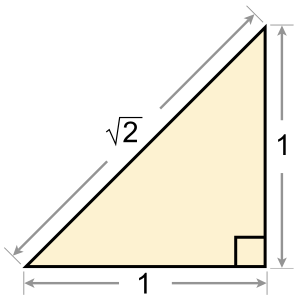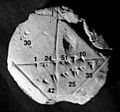Square root of 2 facts for kids
The square root of 2 is a special number in math. You can write it as √2 or 21⁄2. It's a positive number that, when you multiply it by itself, gives you the number 2. For example, if you have a number 'x' and 'x' multiplied by 'x' equals 2, then 'x' is the square root of 2. We call it the principal square root of 2 to show it's the positive one, because there's also a negative number that, when multiplied by itself, also equals 2.
In geometry, imagine a square where each side is 1 unit long. If you draw a line from one corner to the opposite corner (this is called a diagonal), the length of that line is exactly the square root of 2! You can figure this out using the Pythagorean theorem, which is a rule about right triangles. Because of this, the square root of 2 is sometimes called Pythagoras's constant.
Contents
Why the Square Root of 2 is Not a Simple Fraction
The number \sqrt{2} is an irrational number. This means you can't write it as a simple fraction (like 1/2 or 3/4) where both the top and bottom numbers are whole numbers. Here's a way to understand why:
- Imagine for a moment that \sqrt{2} could be written as a fraction. Let's say it's equal to a/b, where 'a' and 'b' are whole numbers.
- We can always simplify a fraction. So, let's pick the simplest version of a/b where 'a' and 'b' don't share any common factors. This means that 'a' and 'b' can't both be even numbers. At least one of them must be an odd number.
- Now, if }, then if we multiply both sides by 'b', we get }.
- If we square both sides of that equation, we get .
- Look at the right side: 2b^2. Since it's 2 times something, it must be an even number.
- This means a^2 must also be an even number. If a number squared is even, then the original number ('a') must also be even. (Think: 3x3=9 (odd), 4x4=16 (even)).
- Since 'a' is even, we can write it as for some other whole number 'k'.
- Let's put this back into our equation . We get .
- This simplifies to .
- Now, if we divide both sides by 2, we get .
- Just like before, 2k^2 is an even number. So, b^2 must be even, which means 'b' itself must be an even number.
- So, we found that 'a' is even AND 'b' is even. But remember, in step 2, we said that 'a' and 'b' couldn't both be even if the fraction was simplified.
- This creates a problem! Our first idea (that \sqrt{2} could be written as a simple fraction) led us to a contradiction. This means our first idea must be wrong.
Therefore, the square root of 2 cannot be written as a simple fraction, which means it is an irrational number.
Related Math Ideas
Images for kids
See also
 In Spanish: Raíz cuadrada de dos para niños
In Spanish: Raíz cuadrada de dos para niños




